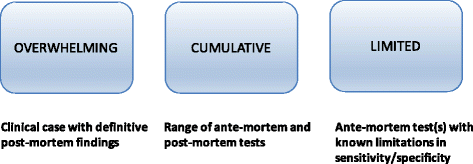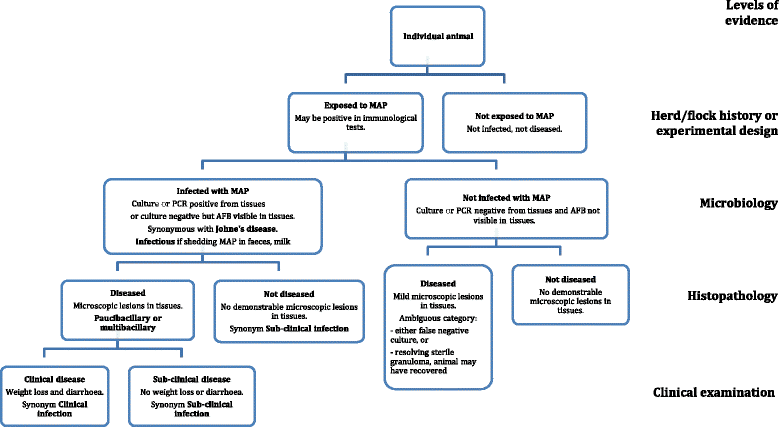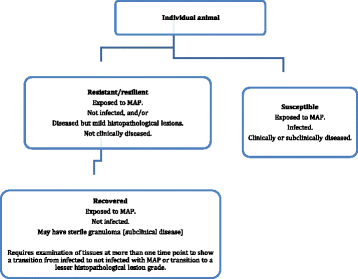Case definition terminology for paratuberculosis (Johne's disease)
- PMID: 29121939
- PMCID: PMC5680782
- DOI: 10.1186/s12917-017-1254-6
Case definition terminology for paratuberculosis (Johne's disease)
Abstract
Paratuberculosis (Johne's disease) is an economically significant condition caused by Mycobacterium avium subsp. paratuberculosis. However, difficulties in diagnosis and classification of individual animals with the condition have hampered research and impeded efforts to halt its progressive spread in the global livestock industry. Descriptive terms applied to individual animals and herds such as exposed, infected, diseased, clinical, sub-clinical, infectious and resistant need to be defined so that they can be incorporated consistently into well-understood and reproducible case definitions. These allow for consistent classification of individuals in a population for the purposes of analysis based on accurate counts. The outputs might include the incidence of cases, frequency distributions of the number of cases by age class or more sophisticated analyses involving statistical comparisons of immune responses in vaccine development studies, or gene frequencies or expression data from cases and controls in genomic investigations. It is necessary to have agreed definitions in order to be able to make valid comparisons and meta-analyses of experiments conducted over time by a given researcher, in different laboratories, by different researchers, and in different countries. In this paper, terms are applied systematically in an hierarchical flow chart to enable classification of individual animals. We propose descriptive terms for different stages in the pathogenesis of paratuberculosis to enable their use in different types of studies and to enable an independent assessment of the extent to which accepted definitions for stages of disease have been applied consistently in any given study. This will assist in the general interpretation of data between studies, and will facilitate future meta-analyses.
Conflict of interest statement
Ethics approval and consent to participate
Not applicable. This article refers to published data and does not require ethics approval or consent.
Consent for publication
Not applicable. This paper does not contain any individual person’s data in any form (including and individual details, images or videos) and so does not require consent to publish.
Competing interests
The authors declare that they have no competing interests.
Publisher’s Note
Springer Nature remains neutral with regard to jurisdictional claims in published maps and institutional affiliations.
Figures



References
-
- Nugent G, Whitford EJ, Hunnam JC, Wilson PR, Cross M, de Lisle GW. Mycobacterium avium subsp. paratuberculosis infection in wildlife on three deer farms with a history of Johne's disease. N Z Vet J. 2011;59(6):293–8. - PubMed
-
- McGregor H, Abbott KA, Whittington RJ. Effects of Mycobacterium avium subsp paratuberculosis infection on serum biochemistry, body weight and wool growth in merino sheep: a longitudinal study. Small Rumin Res. 2015;125:146–53.
MeSH terms
Grants and funding
LinkOut - more resources
Full Text Sources
Other Literature Sources

